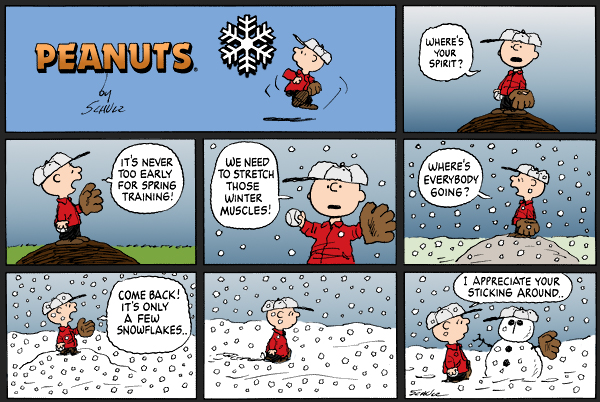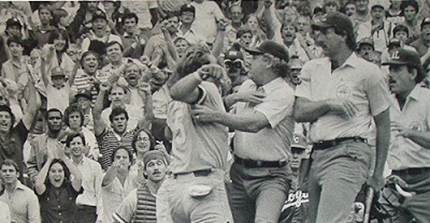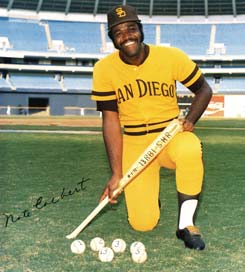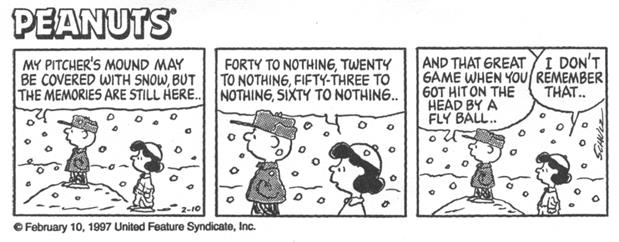
“There are only two seasons – winter and baseball”: So said my favorite baseball owner, Bill Veeck. I got this quote from Inside Pitch, a weekly newsletter from the Baseball Hall of Fame. I recently signed up as a member of the HOF and got a junior membership for my 10-year-old grandson Ian. Within the next year or two, we hope to travel to Cooperstown for our first visit. The Veeck quote led off an article about Hall of Famers Ty Cobb and Ed Walsh who are shown in this photo packing snow to practice throwing curveballs in wintery NY in the early 1920’s. They could also do that this week with the blizzard that hit NY.
All-Time Third Baseman: As you may recall, Ian and grandpa are working through an all-time best lineup. In Hot Stove #2, we picked the outfield (Williams, Mays and Ruth/Aaron). Now we move to the infield. Third base offers a rare opportunity to choose among some contemporary (to me) players: Mike Schmidt, George Brett, Brooks Robinson, Eddie Matthews, Paul Molitor and Wade Boggs. They are six of the seven third basemen voted into the HOF by the sportswriters. The seventh is Pie Traynor from the 20’s and 30’s, long considered the all-time third basemen in a weak field. He has been eclipsed by the more modern six. Brooks was a vacuum sweeper at third (“Mr. Hoover” won 16 Gold Gloves). Matthews was one of the premier power hitters of his era. Boggs was constantly among the batting average leaders, winning five batting titles. Molitor had the most hits, 3,319. But Ian and I think it comes down to Schmidt and Brett. They had exactly the same number of RBI’s (1,595), Schmidt more homers (548 v. 317), George many more doubles and triples, and George a much higher average (.305 v. .267). Schmidt was easily the better fielder, winning ten Gold Gloves to one for George. George finished with 3,154 hits, second only to Molitor, and had batting titles in three decades (1976, 1980 and 1990). He has the highest batting average for a season (.390 in 1980) since Ted Williams hit .406 in 1941. George also has maybe the most famous baseball video clip of all-time (you know the part I mean, at the 2:35 mark of the video). And look at the NY fans below:

You see where I am going? I can rationally argue (rationalize?) that this is a toss-up and will let my hometown bias pick George Brett. Ian agrees. [And, yes, I am aware that George does not fare as well in WAR stats – more on that in a future post]
The Tigers are Coming! The Tigers are Coming!: Owner Mike Ilitch of the Detroit Tigers has said he is willing to spend whatever it takes to get the best baseball players. He knows and accepts that this will trigger the baseball luxury tax, euphemistically the “Competitive Balance Tax.“ When any team exceeds a certain payroll threshold ($189 million in 2016), it must pay the league a tax, ranging from 17.5% to 50% on the excess payroll. Since the inception of the tax in 2003, the Yankees have paid about 75% of the aggregate total of $400 million. The Dodgers broke the season record this past year by paying a tax of $43.7 million. Joining the Dodgers and Yankees ($26.1 million) in 2015 were San Francisco and the Red Sox who each paid less than $2 million. Contracts already in place guaranty that Detroit will join the luxury tax club, but the payoff has been that they have two of the better starting pitchers in baseball and a very formidable lineup.
The Royals are in the same division as the Tigers and have a similar sense of urgency to add the necessary pieces for the championship. The Royals likely will lose several key players to free agency in 2018, and so ownership has been willing to spend more money – not at the luxury tax level, but the $70 million for free agent pitcher Ian Kennedy was a stretch on their comfort level. But if that is the piece needed to complete the puzzle to challenge for the pennant in 2016 and 2017, the cost will seem irrelevant. Detroit’s worry is that several of their best players will be in their 30’s by 2018, and so now is the time to strike.
One other urgency for Detroit. Owner Mike Ilitch will be 87 in July.
The Jock Tax: After Gordon signed the other big contract with the Royals ($72 million), there was some internet chatter about whether or not he was a resident of Nebraska, Missouri or Kansas – and how that would relate to taxes for his big payday. Not as much as one might think. Athletes are subject to income and earnings taxes wherever they work (the “jock tax”), not just in their state of residence. Although this also applies to non-athletes, it is much easier to track the out-of-state work of athletes – just need to look at a season schedule. With interleague play, a baseball player might pay income taxes in over 20 states. So, Alex will pay taxes in New York when the Royals play the Yankees, in Michigan for the Tigers. , and so on. He will play 81 regular season games at the K (and some in St. Louis), and hopefully many playoff games, so Missouri will be there to collect. And Kansas City for its earnings tax. Very complicated and good for the accounting business.
Reader Comments/Vic Power: Hot Stove #3 netted many reader comments on Vic Power. Leland Shurin tells me he was also in the crowd on that first opening day in 1955 and thought Power was a terrific first baseman. Leland was 12 and there with his dad. My opening day fellow truant Jay DeSimone not only saw Power’s first major league game in KC, but his last minor league game with the Blues in 1953. He also remembers Power being run out of an apartment in NKC because he had a white girl friend. Jim and Judy Heeter had dinner with Vic Power in his native Puerto Rico after Power had retired. They were there for an Executive Board meeting for Judy’s employer, the Players Association, and Jim was thrilled to meet one of his childhood heroes. Chris Shanklin believes Power is the best fielding first baseman he ever saw. Political journalist Walter Shapiro remembers having Power’s baseball card back in the 50’s.
Steve Millin offered some good trivia about Power’s record of two steals of home in one game, the only time that has happened in the last 88 seasons. Up to 1927, it had occurred 10 times. Since then, just Vic Power on August 14, 1958. Power had moved on from the KC A’s to Cleveland, and they were playing Detroit. In the 8th inning, coach Eddie Stanky gave Power the green light because the pitcher was using a slow, deliberate windup. He got a good jump and made it easily. The game went into extra innings, and Power was at third base in the 10th with the bases loaded and two out. Rocky Colavito was at the plate and had already hit two homers. After faking a steal of home on the first three pitches to Colavito, Power kept going on the fourth pitch and slid safely under catcher Charlie Lau for the winning run.
Such stories beget more trivia. Charlie Lau would one day become George Brett’s hitting guru. Power was not that speedy – stole only three other bases that year – but as his manager Joe Gordon said, “Those are head plays, not leg plays…baseball instinct…bluffed the pitchers beautifully…then, poof –streaking all the way in.” Does that talk remind you of Eric Hosmer’s instinctive dash to home on the infield play in the World Series? Stealing home is now mostly a lost art as pitchers often work from the stretch rather than using a long windup with a runner on 3rd. Also, the risk of the batter swinging or a big collision with the catcher might give pause to players making millions of dollars. A Royals story on a steal of home: Chris Stynes was a utility player for the Royals in 1995 and 1996. He stole the first three bases of his major league career on May 12, 1996, when he singled off Randy Johnson and then stole second, third and home, the last AL player to do that as of this writing. He stole two more bases the rest of the season.
Reader Comments/Stan Musial: Yet another gem on Stan the Man, this from my Springfield law partner Tom O’Neal:
Lonnie: Joe Porter’s comments on Stan Musial sparked this email on “Stan the Man”. I grew up in Springfield, listening to Harry Caray and, first, Gabby Hartnett. Later, a young Jack Buck would take Gabby’s place. The Cardinals were, and are my team, and Musial was my idol. My mother had a sister who lived in St. Louis who we would visit every year during baseball season. When we were there, we always went to a Cardinal ball game. One year, on May 2nd, 1954 (I looked up the date), we went to a doubleheader between the Cardinals and the Giants. The same Giants mentioned in your article with Willie Mays, Monte Irvin, and the rest. During the two games, Musial hit 3 home runs in the 1st game, the last a game winner. In the 2nd, he hit 2 homers for a total of 5 in the two games. As a 10 year old, I was excited, of course, by the homers, but I did not realize the significance of the feat for several years. After all, wasn’t Stan was supposed to hit home runs ? Of course, I would later find out that it was the first time it had ever happened in baseball history. Tom.
And would happen only one more time to this day. I did a little digging on Tom’s story and surprisingly found the name of another person at old Busch Stadium that same day, 8-year-old Nate Colbert. Like most people in St. Louis, Colbert idolized Stan. Nate honed his own baseball skills as a first baseman and was drafted by his hometown Cardinals in 1964. He had a 10-year major league career, mostly with the San Diego Padres where he found himself on August 1, 1972, some 18 years after he saw Musial hit five homers. The Padres were playing at Atlanta in a doubleheader and Nate hit two homers in the first game and three in the second. His RBI’s (13) and total bases (22) are still the records for a doubleheader. According to one report, the first thing Nate did after reaching the locker room was call his dad, “Dad, remember the game we saw where Stan Musial hit those five home runs?” “Sure do.” “Well, tonight I did it too!” “I knew you could do it Nate.”

When Stan hit those five homers in 1954, he did not have a baseball card from either of the mainstream card companies, Topps and Bowman. He had been on Bowman until 1953, but could not come to terms with either company for 1954. In 1954, he did make a deal with Red Heart, a company that would send out cards in return for its dog food labels. Stan’s 1954 card (below) was one of a unique 33-player series that included Mickey Mantle. Stan had his first Topps card in 1958.

Franchise Musical Chairs: When the music stopped at the NFL meetings, St. Louis had no chair. Not only did the city lose the Rams, but their prior team (now the Arizona Cardinals) had a 13-3 season and played (lost) last Sunday in the NFC championship game. For both the Cardinals and Rams, St. Louis turned out to be a rest stop in a chain of relocations. When I was a kid, our NFL TV in Kansas City was mostly regional coverage of the two teams in Chicago, the Bears (George Blanda) and the Cardinals (John David Crow). In 1960, the Cardinals moved to St. Louis to give the city two sports teams with the same name. Most fans understood that references to the “Cardinals” meant the NL baseball team, and the relocated Chicago team was the “Football Cardinals.” The Football Cardinals moved to Arizona in 1988. The Rams of LA moved to St. Louis in 1995, but now head back to LA for 2016.
To get an AL baseball team and an NBA team, St. Louis lured teams from another beer town, Milwaukee. The Brewers of Milwaukee moved in 1902 to become the Browns of St. Louis, staying until 1953 when they became the Baltimore Orioles. The NBA basketball of my youth featured Bob Pettit of the St. Louis Hawks who had moved from Milwaukee in 1955, stayed for 10 seasons and then moved on to Atlanta.
Kansas City has had similar peripatetic teams. The Philadelphia A’s moved to KC in 1955 and Charlie Finley moved them to Oakland in 1968. The Cincinnati Royals of the NBA moved to KC in 1972 and became the Kings (the Royals name was taken in KC), and then moved on to Sacramento in 1985. I fondly remember Tiny Archibald, Sam Lacey, Scotty Wedman, Otis Birdsong, Phil Ford and the other Kings. I had season tickets with Rich Ellison and Ray Webb, six rows back from the court. Although the team only gave us 13 seasons, we got to see players from an NBA golden era: Wilt, Michael, Magic, Bird, Kareem, Dr. J, The Iceman, Isiah, Moses, The Big E, The Big O, West, Walt “Clyde” Frazier, Havlicek, Jo Jo, Pistol Pete, Earl the Pearl, Walton, etc. And of course, Lonnie Shelton of the Knicks/Supersonics/Cavaliers.
The Kansas City Ballet (Basket) Ball: While I am on the subject of the NBA, I want to give a shout-out to Tyronn Lue who last week was named the new coach of LeBron James and the Cleveland Cavaliers. There is strong local connection – Lue was a star basketball player for Raytown High School and then had a stellar career at Nebraska and 10 years in the NBA. He played in what many consider to be the best high school basketball game ever played in Kansas City – his undefeated Raytown team against KC Central led by legendary coach Jack Bush. On March 4, 1995, 11,000 fans jammed into 10,000 seat Municipal Auditorium for an early round of the state tournament. On that same night, the annual Kansas City Ballet Ball was being held at what was then the Alameda Hotel. The connection? Read on.
My law partner Irv Blond has long been a KC high school basketball fan. He was a starting guard for three years on a very good Pem Day squad and over the years has followed the likes of Warren Armstrong, Larry Drew, Lucius Allen, Anthony Peeler, Jon Koncak, Jon Sunvold and the Rush brothers as they went from KC to college to the NBA. So, he of course wanted to see the Raytown/Central game. But there was a conflict – Irv and his wife Sharyn (a KC Ballet board member) were signed up for the Ballet Ball. Irv settled on a one-person compromise: he would go to the Ballet Ball, slip away in the middle for a couple of hours and then come back. The other wives were not supportive and the other husbands were jealous. When he parked his car for the game, he exchanged his tuxedo jacket for a parka and joined the overflow crowd. The game was a real barn-burner. Tyronn Lue and his Raytown team were ahead by 3 points with the clock winding down. Central’s star Derek Hood had taken two 3-point shots all season, missing both, but he hit a clutch 3-pointer with 8 seconds left. Overtime! And then…a 2nd overtime, with Central finally winning. Irv? He saw it all and then rejoined Sharyn at the ball at about 11:30. No cell phones in those days.
Coming Soon to Hot Stove: WAR,; Spring Training; All-Time Shortstop (Honus Wagner, Ripken, Yount, Banks, etc.?); The Players’ Tribune; Pat McInerney and I discuss “The Catch” and “The Other Catch”.
Until then,
